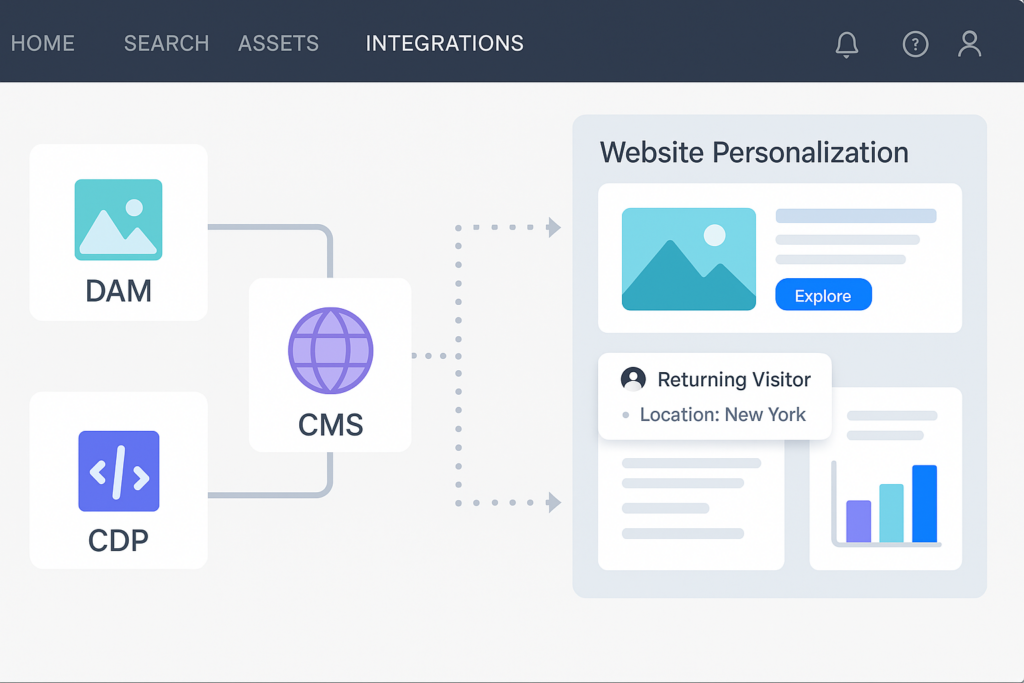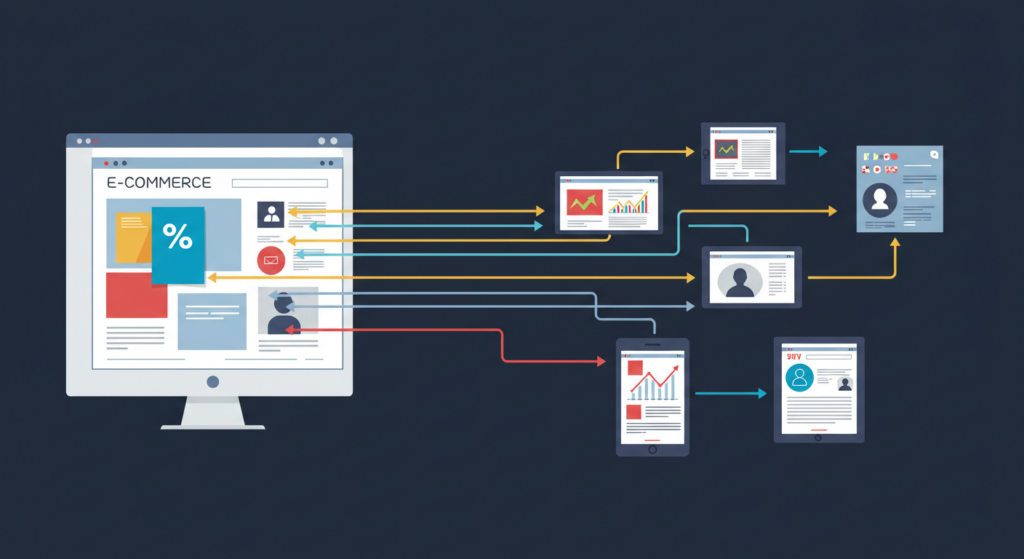Personalized content is a growth strategy, especially when 81% of consumers expect tailored experiences. Marketers are turning to website personalization tools to meet customer expectations and drive measurable business results. These tools have evolved far beyond simple user segmentation. Today’s solutions use behavioral data, AI-powered insights, and content intelligence to tailor digital experiences in real time, whether the visitor is a known customer or an anonymous browser.
Personalization at scale doesn’t happen by accident. It requires the right infrastructure. From intelligent content tagging to dynamic asset delivery, this blog explores how modern marketers are operationalizing personalization to boost efficiency, optimize content investments, and unlock new revenue potential.
Turning Website Personalization Tools Into Growth Engines
Website personalization tools are strategic enablers of business growth. When embedded into the content lifecycle, they give marketers the agility to deliver relevance at scale, improving everything from engagement to conversion rates. Explore why personalization is a critical driver of performance, how it’s evolving in a post-cookie world, and why speed and intelligence now matter more than ever.
Why Personalization Is a Business Imperative
The stakes for personalization are high. As digital competition intensifies, customer attention is fleeting, and brands that fail to connect in meaningful ways risk being left behind. Studies show that 89% of businesses that invest in personalization are seeing hikes in ROI. While delighting users, it’s about driving growth through relevance.
Effective personalization is directly tied to content performance. When the right message reaches the right audience at the right moment, conversion rates go up, bounce rates go down, and brand loyalty deepens. For marketers, personalization is the fastest path to turn passive content into active revenue generators.
Moving Beyond Cookies: Personalization for All Visitors
Traditional personalization methods relied heavily on third-party cookies or CRM-driven identifiers. But as regulations tighten and browsers phase out cookies, marketers are forced to rethink their approach. Leading teams are now leveraging zero-party data, behavioral signals, and AI to personalize experiences even for anonymous users.
Website personalization tools have adapted by making content decisions based on intent, location, behavior, and real-time signals rather than static profiles. This shift allows marketers to serve relevant experiences without relying on personally identifiable information, expanding personalization’s reach and future-proofing it against data privacy shifts.
The New Standard: Real-Time Content Decision-Making
Relevance delayed is relevance denied. Rather than suggesting content, today’s personalization tools decide which assets to show, when, and to whom. This capability is powered by AI that processes user behavior, content metadata, and performance patterns to deliver hyper-specific experiences instantly.
Real-time decision-making also supports omnichannel consistency. Whether it’s a homepage, product page, email, or support portal, every interaction can be tailored on the fly. This responsiveness improves user experience and maximizes the ROI of every content asset.
Inside the Tech: What Modern Website Personalization Tools Can Actually Do
Marketers need precision. Modern website personalization tools have matured into intelligent systems that analyze, adapt, and act on user behavior in real time. Take a look at the specific capabilities fueling smarter, faster, and more scalable content experiences, none of which were possible just a few years ago.

Predictive Metadata and Content Tagging
One of the most transformative shifts in personalization has been the rise of predictive metadata. Rather than relying on manual tagging, AI now scans images, videos, and documents to auto-generate metadata aligned with brand-specific taxonomies. Brands achieve faster asset organization, better searchability, and more accurate personalization triggers.
Smart tagging ensures that every asset is rich with contextual signals. This metadata can be ingested by personalization engines to determine when and how to serve specific content. By streamlining this layer, marketers can scale content delivery across audience segments without getting buried in asset management complexity.
Real-Time Personalization Across Channels
Modern tools orchestrate experiences across an entire digital ecosystem. Whether it’s a homepage banner, product description, email, or mobile app notification, AI-powered platforms tailor content dynamically across touchpoints, improving continuity and engagement.
Marketers can deliver the same message in different formats, optimized for each channel and moment. For instance, a visitor who views a product page might later receive a personalized how-to video via email, bridging content and commerce in a seamless, conversion-driven flow.
Seamless Integration with CMS, CDP, and DAM
The most powerful website personalization tools are built to plug into the broader martech ecosystem. Integrations with content management systems (CMS), customer data platforms (CDP), and digital asset management (DAM) platforms allow for fluid workflows and real-time content delivery without duplication or lag.
These connections are vital for operationalizing personalization at scale. Instead of siloed systems, marketers can synchronize customer data with approved assets, automate compliance checks, and deploy content instantly while maintaining brand consistency and governance. It’s personalization without the friction.
Strategy Meets Execution: How Marketers Are Winning with Personalization
Having the right tools is only part of the solution. To unlock true ROI, marketing teams must embed personalization into workflows, aligning it with content strategy and continuously optimizing based on results. Here’s how marketers are translating tech into impact through smarter execution.
Identifying and Filling Content Gaps with AI Insights
One of the most common blockers to effective personalization is a content gap—when the right content for a given audience or moment simply doesn’t exist. AI-driven content intelligence helps marketers uncover these blind spots by analyzing how users engage with content, where they drop off, and what’s missing from the journey.
By identifying gaps, teams can prioritize high-impact content creation instead of guessing what might resonate. These insights also guide content reuse and modularization, helping marketers deliver more with less while ensuring every new piece of content aligns with demand and performance data.
Enabling Scalable Personalization Without More Headcount
Personalization is often perceived as resource-heavy, but it doesn’t have to be. Intelligent automation, such as AI-powered content tagging, auto-generated variants, and modular asset reuse, makes it possible to scale personalized experiences without scaling the team.
Instead of manually creating ten different versions of an asset for ten audiences, marketers can generate dynamic versions on the fly, using pre-tagged content blocks and audience logic. Your teams can reduce content creation costs and accelerate campaign timelines, enabling higher productivity without burnout.

Measuring What Matters: Conversion and Content ROI
Modern personalization tools are tightly integrated with analytics engines, enabling marketers to track how personalized content performs across funnels and channels. Metrics like conversion lift, time-on-page, and revenue attribution are now table stakes.
More advanced platforms also support “return on effort” (ROE) tracking, helping marketers understand which content delivers the most impact relative to the resources required. These insights guide future content planning and resource allocation, ensuring personalization remains sustainable, efficient, and profitable.
Expert Tips: Don’t Just Personalize—Operationalize
Personalization doesn’t work in a vacuum. To make it sustainable and scalable, marketers must weave personalization into the fabric of their content operations. These expert tips focus on making personalization repeatable, efficient, and consistently impactful.
Tip: Build personalization into your content operations
Suggested Action: Map your personalization workflows to the full content lifecycle, from planning and creation to optimization and reuse.
It’s not enough to tack personalization onto the end of your process. It needs to be considered from the start. That means defining audience segments early, building campaign briefs that account for personalization triggers, and integrating personalization tools into your review and deployment workflows.
Teams that treat personalization as a system rather than a one-off tactic see faster turnaround times, higher content reuse, and fewer gaps. When everyone from content creators to compliance reviewers is aligned on personalization goals, the entire operation becomes more agile and effective.
Tip: Focus on modular content for flexible delivery
Suggested Action: Break down content into reusable components that adapt easily to different audiences and platforms.
Modular content is the backbone of scalable personalization. By designing assets as flexible, swappable blocks, such as headlines, product shots, or CTAs, marketers can create endless variations from a single source. You can reduce production strain and ensure brand consistency across all channels.
With the help of DAM platforms and personalization engines, modular content can be automatically assembled based on user data or behavior. The result? Faster time to market, higher content ROI, and a personalization engine that runs without constantly reinventing the wheel.
Tip: Build compliance into your personalization workflows
Suggested Action: Use tools with built-in brand governance features to automate reviews, approvals, and digital rights checks before content goes live.
As personalization scales, so does risk. When teams are generating dynamic content across regions, platforms, and audience types, it’s easy for brand inconsistencies or compliance issues to slip through. Governance needs to be part of your personalization stack, not an afterthought.
Leading platforms now offer AI-powered content detection, automated review workflows, and rights management that ensure every piece of content meets legal, regulatory, and brand standards. With the right checks in place, marketers can move fast without compromising control while avoiding costly clean-up after the fact.
Growth Through Relevance: Success Stories That Stand Out
The shift to personalization is delivering real-world results. Marketers across industries are using intelligent content operations to meet rising expectations while improving speed, precision, and ROI. The following measurable wins show how personalization strategies translate into tangible growth.
Real Brands, Real Results: From Bounce Rate Drops to Revenue Gains
Brands that have fully embraced content personalization are seeing meaningful performance enhancements. One retailer achieved an 18% revenue increase and a 22% drop in bounce rates by using real-time segmentation and content adaptation across its website. These weren’t minor tweaks; they were structural improvements driven by content intelligence and automation.
From optimizing homepages to serving behavior-triggered content on product pages, these companies proved that personalization isn’t just about feel-good experiences but rather guiding users to action. The better the relevance, the faster users convert.
The ROI of Personalization: Performance Gains Without Overspend
A common myth is that personalization requires massive teams and bloated budgets. But many success stories show the opposite. A global consumer goods brand used AI-generated content variants and automated approvals to reduce asset creation time by 80% while boosting reuse by over 400%. These efficiencies made personalization more cost-effective, not more expensive.
When content ops are aligned with personalization goals, teams stop duplicating effort and start unlocking value from what they already have. Personalization becomes a growth strategy, not a cost center.
From Static to Self-Evolving: How AI Is Reshaping Content Strategy
Traditional content strategies are often static, planned quarterly, based on gut feel or limited engagement data, and updated infrequently. But AI-powered website personalization tools are changing that. By continuously analyzing how users interact with content and which pieces drive conversion, these systems provide a real-time feedback loop that turns every interaction into an insight.
Marketers can move from guesswork to precision. Behavioral modeling tools detect which segments engage with which content types, what assets are underperforming, and where content gaps are costing you conversions. Instead of relying on lagging indicators, marketers can now adjust strategies in-flight, whether that means refreshing a call to action, retiring a low-performing banner, or cloning and adapting a high-performing landing page for a new audience.

The result is a self-optimizing content strategy that evolves with your users, learns from every click, and reallocates resources toward what works. For content marketers, this represents a fundamental shift: from creating content based on assumptions to scaling what’s proven to perform. And it’s only possible with AI-enabled personalization platforms that tie content usage directly to business outcomes.
Power Personalized Experiences at Scale
As customer expectations rise and content demands grow more complex, personalization is a performance driver. Website personalization tools have evolved into intelligent systems that help shape strategy, accelerate execution, and unlock measurable growth. From AI-driven asset selection to real-time decision-making across channels, the brands winning today are those that treat personalization as a business system, not a bolt-on.
At Aprimo, we help marketers go beyond basic personalization by connecting content strategy, operations, and delivery in one intelligent system. Our platform pairs AI-powered Digital Asset Management with real-time content personalization and predictive metadata tagging so you can deliver the right content to the right audience at the right time. Whether you’re personalizing a homepage, scaling content variants, or optimizing performance across channels, Aprimo equips you to do it faster, smarter, and with less manual lift. Book a demo to see how we can help you personalize content and operationalize it.


